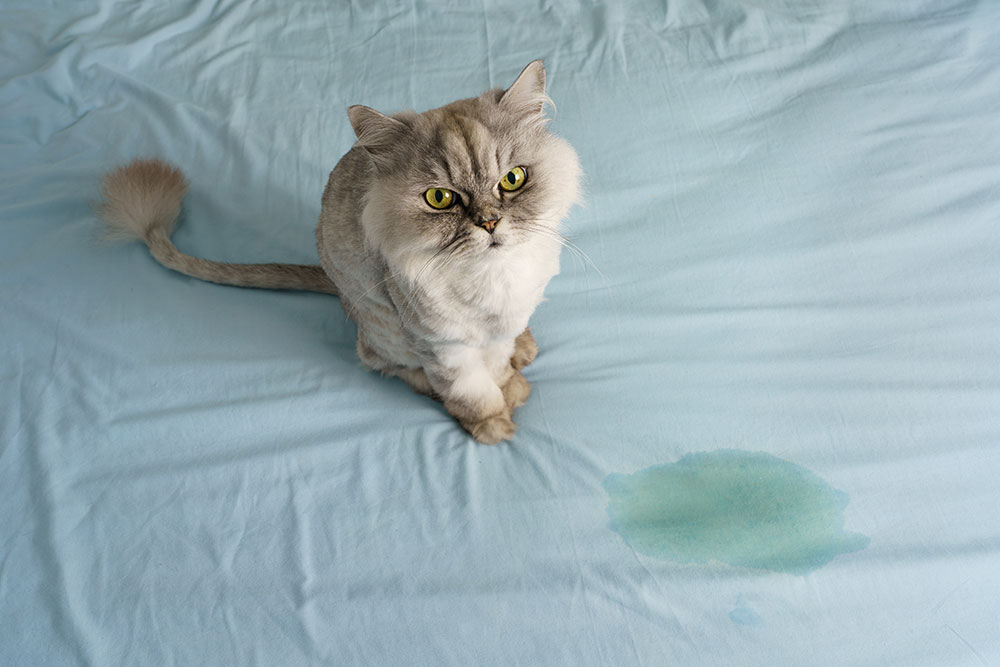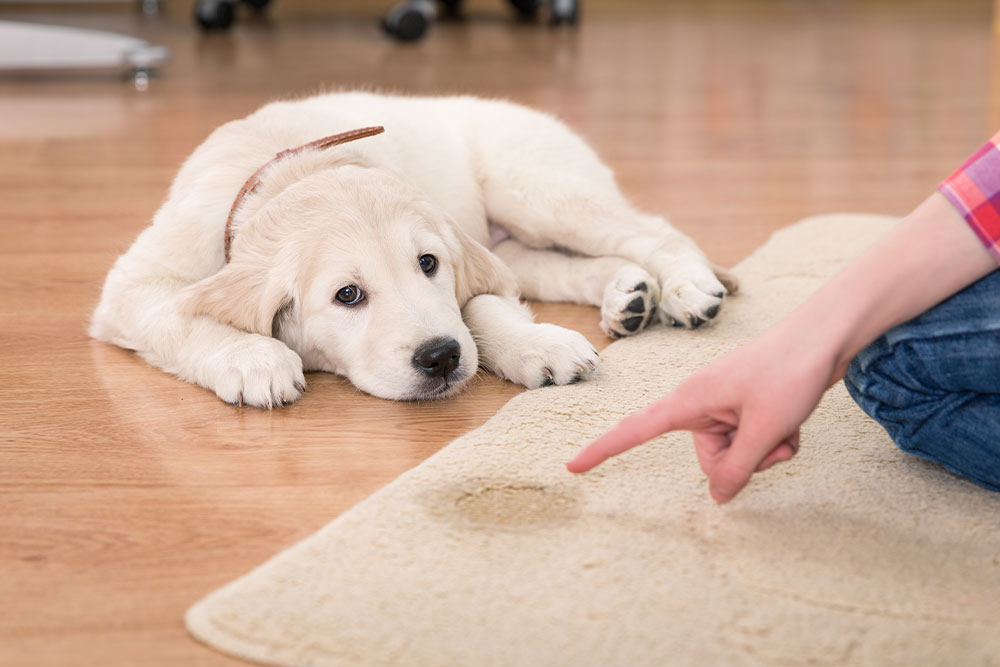At Stanton Pet Hospital, we understand how upsetting it can be when your dog or cat is in pain or discomfort—especially when the symptoms involve frequent accidents, straining, or constant licking. Urinary tract infections (UTIs) are one of the most common causes of these signs, but they aren’t the only ones. That’s why understanding the full range of causes, along with effective treatment and prevention strategies, is key to keeping your pet comfortable and healthy.
What Causes UTIs in Pets?
A urinary tract infection occurs when bacteria enter the bladder or urethra, leading to inflammation and discomfort. While UTIs can affect any pet, certain risk factors make them more likely in some individuals.
Common Causes of UTIs Include:
- Bacterial contamination from the skin or feces entering the urethra
- Incomplete bladder emptying, allowing bacteria to grow in retained urine
- Bladder stones or urinary crystals, which trap bacteria and irritate the bladder lining
Learn more about urinary stones
- Dehydration, which leads to concentrated urine that encourages bacterial growth
- Underlying health conditions, such as diabetes or kidney disease
When It’s Not Just a UTI: Other Causes of Similar Symptoms
While bacterial infections are a common explanation, many pets with UTI-like signs are actually dealing with another underlying issue. Recognizing these possibilities is important, especially in pets with recurring symptoms.
1. Anatomical Abnormalities
Some pets—especially spayed female dogs—have conformational challenges such as recessed vulvas or deep perivulvar skin folds. These folds trap moisture and bacteria, leading to chronic irritation or infection. In these cases, medical management may not be enough.
- Surgical correction, such as a vulvoplasty (episioplasty) or skin fold resection, may be recommended to remove excess tissue and improve airflow and hygiene in the area.
2. Skin Infections and Allergies
Allergies (environmental or food-related) can cause persistent inflammation, licking, and skin infections near the genital area.
- Constant licking leads to secondary bacterial or yeast infections, which can mimic UTI symptoms or create an entry point for bacteria.
- Dermatitis, moist skin folds, or chronic irritation may be diagnosed and treated alongside any urinary tract issues.
- We may recommend an Elizabethan collar (cone) to prevent further self-trauma during healing.
3. Scooting or Genital Discomfort
Licking, scooting, or dragging the hind end can be signs of anal gland issues, parasites, or generalized itching—not just urinary infections. A full physical exam helps identify the root cause.
4. Diarrhea or GI Upset
Frequent soft stools or diarrhea can cause perineal irritation, especially in long-haired dogs. This discomfort often leads to licking and scooting that resemble UTI symptoms but are actually GI-related.
5. Tumors or Masses
Masses in or around the bladder, urethra, or genital area can lead to straining, blood in the urine, or frequent urination.
- These may require imaging and biopsy to confirm and treat appropriately.
Signs and Symptoms of UTIs (and Similar Conditions)
It’s important to be alert to the symptoms of a urinary tract issue, especially when they overlap with other health conditions.
What to Watch For:
- Frequent urination in small amounts
- Straining or pain when urinating
- Blood in the urine
- Foul-smelling or cloudy urine
- Licking the genital area
- House soiling or urinating outside the litter box
- Scooting or dragging hindquarters
Emergency Signs:
- Inability to urinate (especially in male cats)
- Crying out or vocalizing when urinating
- Vomiting, lethargy, or collapse
- Firm, bloated abdomen
Read more about urinary obstruction in male cats.
How UTIs and Related Issues Are Diagnosed
At Stanton Pet Hospital, we perform a full exam and recommend targeted diagnostics to determine whether your pet’s symptoms are caused by a UTI or something else.
Diagnostic Tools May Include:
- Urinalysis: Detects bacteria, crystals, blood, and inflammatory markers
- Urine culture and sensitivity: Identifies specific bacteria and the most effective antibiotics
- Bloodwork: Screens for kidney disease, diabetes, or other systemic illnesses
- X-rays or ultrasound: Detects bladder stones, masses, or structural abnormalities
- Skin cytology or scraping: Helps evaluate for secondary skin infections or allergies
Learn more about UTIs from Cornell
Treatment Options
Antibiotics
If a bacterial infection is confirmed, we’ll prescribe an antibiotic based on culture results. Completing the full course is crucial to preventing recurrence.
Pain Relief
We may prescribe anti-inflammatories or pain medications to keep your pet comfortable as they recover.
Hydration Support
Encouraging your pet to drink more water helps flush bacteria from the urinary tract.
- Offer multiple bowls of clean, fresh water
- Switch to canned or moisture-rich food
- Use a pet water fountain to entice drinking
Dietary Support
Prescription diets may help dissolve urinary crystals or prevent stone formation. These are often part of long-term care plans for pets with recurrent issues.
Surgical Options
If your pet has bladder stones, tumors, or conformational abnormalities, surgery may be necessary for a lasting solution.
Preventing Future UTIs and Related Problems
Prevention starts with supporting urinary health and hygiene every day.
Tips to Reduce Risk:
- Ensure fresh water is always available
- Feed a veterinarian-approved urinary diet, if recommended
- Encourage regular potty breaks (don’t let dogs “hold it” too long)
- Scoop litter boxes daily to encourage consistent use
- Keep your pet’s genital area clean and trimmed, especially in long-haired breeds
- Address underlying issues like obesity, diabetes, or skin allergies early
- Use cones or protective gear if your pet has a tendency to lick or chew persistently
Routine Screening Matters
For pets with a history of UTIs or chronic urinary signs, regular check-ups and urine testing are essential.
- Annual exams often include urinalysis, but some pets may benefit from biannual screenings if they’re at higher risk.
How Stanton Pet Hospital Can Help
Our team is dedicated to helping you get to the bottom of your pet’s urinary symptoms with:
- Comprehensive diagnostics and exams
- On-site lab work and imaging for faster answers
- Tailored treatment plans—not just antibiotics, but holistic care
- Preventive advice and follow-up to reduce future flare-ups
If your pet is showing signs of discomfort, licking, accidents, or straining, don’t wait. Request an appointment today and let us help you get answers—and relief—for your companion.
UTIs are common—but not always straightforward. From anatomical issues to allergies to bladder stones, many conditions can cause similar signs. That’s why accurate diagnosis, comprehensive treatment, and ongoing prevention are essential.
At Stanton Pet Hospital, we’re here to make sure your pet isn’t just treated, but truly supported for long-term comfort and wellness.
Contact us today to learn more or schedule a visit.







Leave A Comment